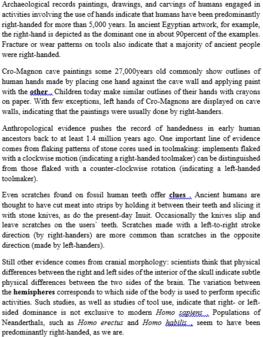Read the following passage and mark the letter A, B, C, or D on your answer sheet to indicate the correct answer to each of the questions from 35 to 42.
Life in the Universe
Exobiology is the study of life that originates from outside of Earth. As yet, of course, no such life forms have been found. Exobiologists, however, have done important work in the theoretical study of where life is most likely to evolve, and what those extrateưestrial life forms might be like.
What sorts of planets are most likely to develop life? Most scientists agree that a habitable planet must be terrestrial, or rock-based, with liquid surface water and biogeochemical cycles that somewhat resemble Earth’s. Water is an important solvent involved in many biological processes. Biogeochemical cycles are the continuous movement and transformation of materials in the environment. These cycles include the circulation of elements and nutrients upon which life and the Earth’s climate depend. Since (as far as we know) all life is carbon-based, a stable carbon cycle is especially important.
The habitable zone is the region around a star in which planets can develop life. Assuming the need for liquid surface water, it follows that most stars around the size of our sun will be able to sustain habitable zones for billions of years. Stars that are larger than the sun are much hotter and bum out more quickly; life there may not have enough time to evolve. Stars that are smaller than the sun have different problem. First of all, planets in their habitable zones will be so close to the star that they will be “tidally locked” – that is one side of the planet will always face the star in perpetual daylight with the other side in the perpetual night. Another possible obstacle to life on smaller stars is that they tend to vary in their luminosity, or brightness, due to flares and “star spots”. The variation can be large enough to have harmful effects on the ecosystem.
Of course, not all stars of the right size will give rise to life; they also must have terrestrial planets with the right kind of orbits. Most solar systems have more than one planet, which influence each other’s orbits with their own gravity. Therefore, in order to have a stable system with no planets flying out into space, the orbits must be a good distance from one another. Interestingly, the amount of space needed is roughly the width of a star’s habitable zone. This means that for life to evolve, the largest possible number of life-supporting planets in any star’s habitable zone is two.
Finally, not all planets meeting the above conditions will necessarily develop life. One major threat is large, frequent asteroid and comet impacts, which will wipe out life each time it tries to evolve. The case of Earth teaches that having large gas giants, such as Saturn and Jupiter,.in the outer part of the solar system can help keep a planet safe for life. Due to their strong gravitation, they tend to catch or deflect large objects before they can reach Earth.
All of the following are mentioned in the passage as necessary for the development of life except
A. rock
B. carbon
C. oxygen
D. water




Đáp án C
Kiến thức: Đọc hiểu
Giải thích:
Tất cả những điều sau đây được đề cập trong đoạn văn để cần thiết cho sự phát triển sự sống, Trừ:
A. đá
B. Carbon
C. khí oxy
D. nước
Thông tin: Most scientists agree that a habitable planet must be
terrestn rock-based, with liquid surface water ….. Since (as far as we know) all life is carbon-based
Tạm dịch: Hầu hết các nhà khoa học đồng ý rằng một hành tinh sống phải có đá trên mặt, với nước… Như chúng ta biết, tất cả cuộc sống của chúng ta đều dựa vào carbon…